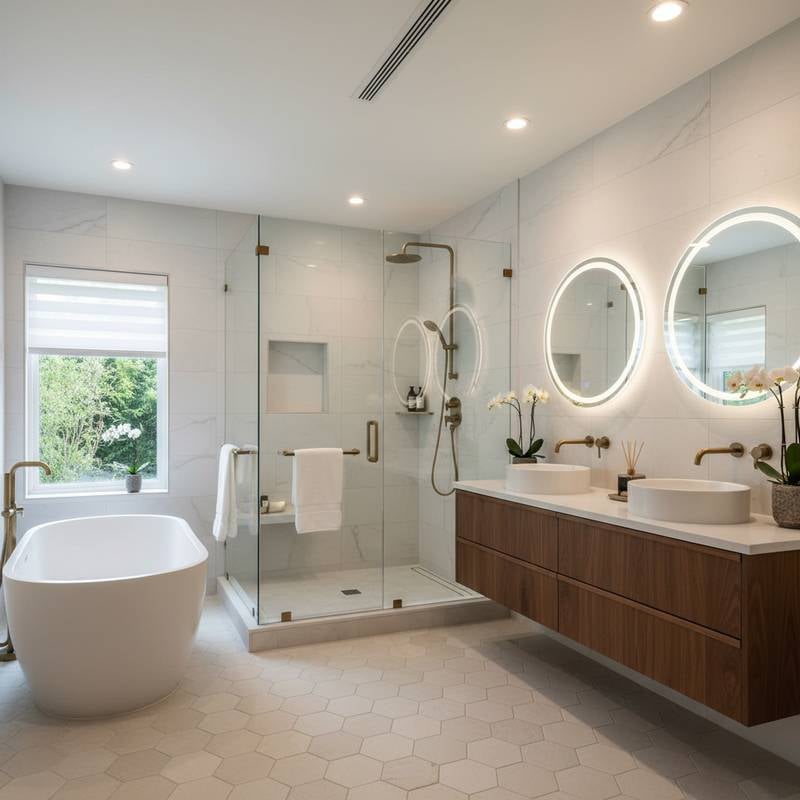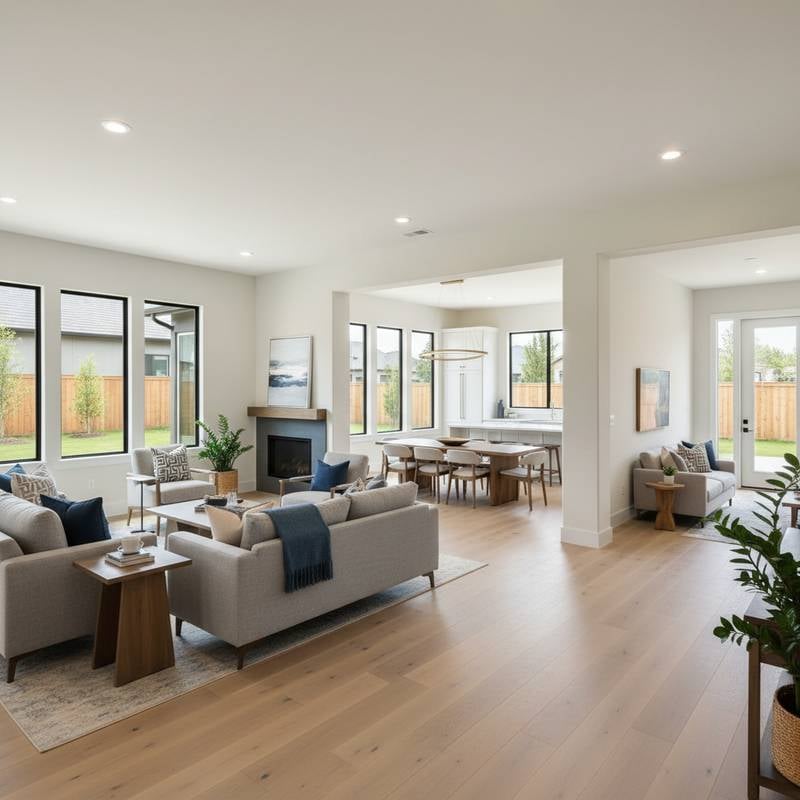Introduction to Value-Enhancing Luxury Upgrades
Homeowners seeking to maximize resale value often turn to luxury features that blend functionality with sophistication. In 2025, buyers prioritize properties that offer modern efficiency, personalized comfort, and timeless elegance. Select upgrades not only elevate daily living but also deliver substantial returns, with many achieving 10 to 25 percent increases in property value. This guide examines proven features, their costs, and implementation strategies to help you invest wisely.
Key considerations include aligning upgrades with local market demands and focusing on durable, high-quality materials. Professional execution ensures these additions meet building codes and enhance curb appeal. By prioritizing features that appeal to affluent buyers, you position your home as a premium offering in competitive real estate landscapes.
Gourmet Kitchens: The Heart of High ROI
A gourmet kitchen serves as a central hub for entertaining and everyday use, making it one of the top value boosters. Install professional-grade appliances such as double ovens, induction cooktops, and built-in refrigerators to create a space that rivals fine dining establishments. Custom island designs with seating for four or more, paired with quartz or granite countertops, add both utility and visual impact.
Expect costs to range from $50,000 to $150,000 for a full renovation, depending on square footage and material choices. ROI typically reaches 15 to 25 percent, as buyers view these kitchens as essential for modern lifestyles. To optimize returns, incorporate energy-efficient lighting and smart faucets that conserve water while maintaining a sleek appearance.
Subtle details like under-cabinet organization systems and wine-integrated storage elevate the design without excessive expense. These elements ensure the kitchen feels expansive and tailored, drawing buyers who appreciate culinary innovation.
Spa-Like Bathrooms: Retreats That Command Premium Prices
Transform ordinary bathrooms into serene spas to capture buyer interest in wellness-focused homes. Key additions include oversized soaking tubs, rainfall showerheads with multiple jets, and heated flooring for year-round comfort. Natural stone tiles and floating vanities contribute to a luxurious, spa-inspired atmosphere.
Renovation expenses generally fall between $25,000 and $80,000, influenced by plumbing updates and fixture selections. These upgrades often yield 12 to 20 percent ROI, particularly in master suites where relaxation features stand out. Integrate steam enclosures or body sprays to enhance the therapeutic experience, appealing to health-conscious purchasers.
Focus on ventilation systems that prevent moisture buildup, ensuring longevity. Soft LED lighting and custom medicine cabinets with integrated mirrors add practicality, making the space both indulgent and functional for resale.
Smart Home Technology: Efficiency Meets Innovation
Integrating smart technology streamlines home operations and appeals to tech-savvy buyers. Install whole-home automation systems that control lighting, security cameras, and climate via voice commands or apps. Voice-activated assistants in key areas, combined with automated blinds, create a seamless, futuristic environment.
Initial setup costs vary from $10,000 to $40,000, covering wiring, hubs, and devices. Returns average 10 to 18 percent, driven by energy savings and enhanced security perceptions. Prioritize compatible ecosystems like those supporting multi-room audio and smart locks to future-proof the investment.
Professional calibration ensures reliable performance, avoiding connectivity issues that could deter buyers. These systems not only reduce utility bills but also position the home as forward-thinking, increasing its market desirability.
Outdoor Living Spaces: Extending Comfort Beyond Walls
Expand living areas with outdoor features that blur indoor-outdoor boundaries. Construct covered patios with built-in grills, fire pits, and outdoor kitchens equipped for al fresco dining. Landscape integration, such as native plantings and water features, enhances privacy and aesthetic appeal.
Project budgets range from $20,000 to $100,000, based on size and amenities like infinity-edge pools. ROI hovers at 10 to 20 percent, especially in regions with favorable climates where buyers seek entertainment-ready yards. Durable, weather-resistant materials like teak furniture and stone paving ensure year-round usability.
Incorporate smart irrigation and lighting to maintain efficiency. These spaces transform properties into lifestyle destinations, attracting families and entertainers willing to pay a premium.
Specialized Features: Wine Rooms and Saunas for Unique Appeal
For discerning buyers, dedicated wine rooms with climate-controlled storage and tasting bars add exclusivity. Saunas, whether traditional or infrared, provide private wellness escapes. These niche upgrades cost $15,000 to $50,000 each and offer 8 to 15 percent ROI through emotional differentiation.
Position wine rooms in basements or pantries with custom racking for 200-plus bottles. Saunas fit well in master baths or gyms, using cedar paneling for aroma and durability. While not universal, they shine in luxury segments, helping homes stand out in listings.
Balance these with broader appeal by ensuring accessibility and low maintenance. Such features signal thoughtful customization, boosting perceived value.
Contractor Costs and Professional Installation
Luxury projects demand skilled oversight to achieve precision. Contractors charge 15 to 25 percent of the total budget for coordination, permitting, and quality control. This fee covers sourcing materials and managing timelines, essential for complex integrations like electrical rewiring or structural modifications.
Homeowners occasionally manage simple tasks, such as selecting finishes, but core work requires licensed experts. Faulty installations risk voiding warranties, compromising safety, and diminishing returns. Always verify credentials and review portfolios to select reliable teams.
Strategies to Reduce Costs on Premium Upgrades
Efficiency in planning minimizes expenses without sacrificing quality. Bundle renovations across rooms to streamline labor and equipment rentals. Opt for semi-custom options, like modular cabinetry from reputable suppliers, which deliver bespoke looks at lower fabrication costs.
Leverage existing infrastructure by adapting plumbing lines or electrical panels rather than full replacements. Choose enduring elements, such as matte black hardware and oak flooring, over fleeting trends. Solicit bids from at least three contractors, specifying materials and scopes for accurate comparisons.
Phased approaches allow funding flexibility, starting with high-impact areas like kitchens before expanding to outdoors.
Understanding Return on Investment
ROI calculations factor in upgrade costs against increased resale prices, drawn from real estate data. Kitchen and bathroom enhancements lead with the highest returns due to their daily relevance. Smart tech and outdoor areas follow, offering tangible benefits like lower bills and expanded usability.
Niche additions like wine rooms provide indirect value by enhancing market uniqueness. Custom audio-visual systems and designer lighting further polish the property's presentation. Overall, combined features create synergy, often exceeding individual ROIs through comprehensive appeal.
Market analysis shows these investments perform best in upscale neighborhoods where buyers expect premium amenities.
Cost Estimation Basics
Figures presented here derive from national contractor reports, supplier pricing, and analyses of upscale renovations. Averages account for mid-range to luxury executions in homes valued over $500,000. Variations arise from regional factors, such as higher labor in urban centers or material transport in remote areas.
Obtain site-specific quotes by sharing blueprints and preferences with professionals. Factor in contingencies for unforeseen issues, like subfloor repairs, to maintain budget integrity.
DIY Opportunities Versus Professional Expertise
Certain enhancements suit DIY efforts, particularly cosmetic ones. Swap out cabinet pulls, apply fresh paint in neutral tones, or set up basic smart devices like thermostats. These tasks require minimal tools and provide quick satisfaction.
Reserve structural or technical work for specialists. Fabricating stone surfaces, installing gas lines, or wiring automation demands certifications to avoid hazards. Initial savings from DIY often pale against repair costs from errors.
Hybrid models work well, with pros handling cores and owners contributing finishes.
Safeguarding Your Upgrades for Lasting Value
Preservation extends the lifespan and appeal of luxury investments. Implement daily routines like wiping surfaces and updating software for tech components. Seal natural stones annually and service mechanicals per manufacturer guidelines.
Keep records of installations, including receipts and manuals, to build buyer confidence. Arrange yearly checks for systems like pools or automation to catch issues early. This diligence underscores the home's superior condition, supporting higher offers.
Building a Home That Endures and Excels
Strategic luxury features fortify your property's financial and aesthetic foundation. Emphasize elements that promote ease, resilience, and joy in living. Through expert guidance and smart choices, you craft a residence that not only satisfies current needs but also secures premium returns for the future.











